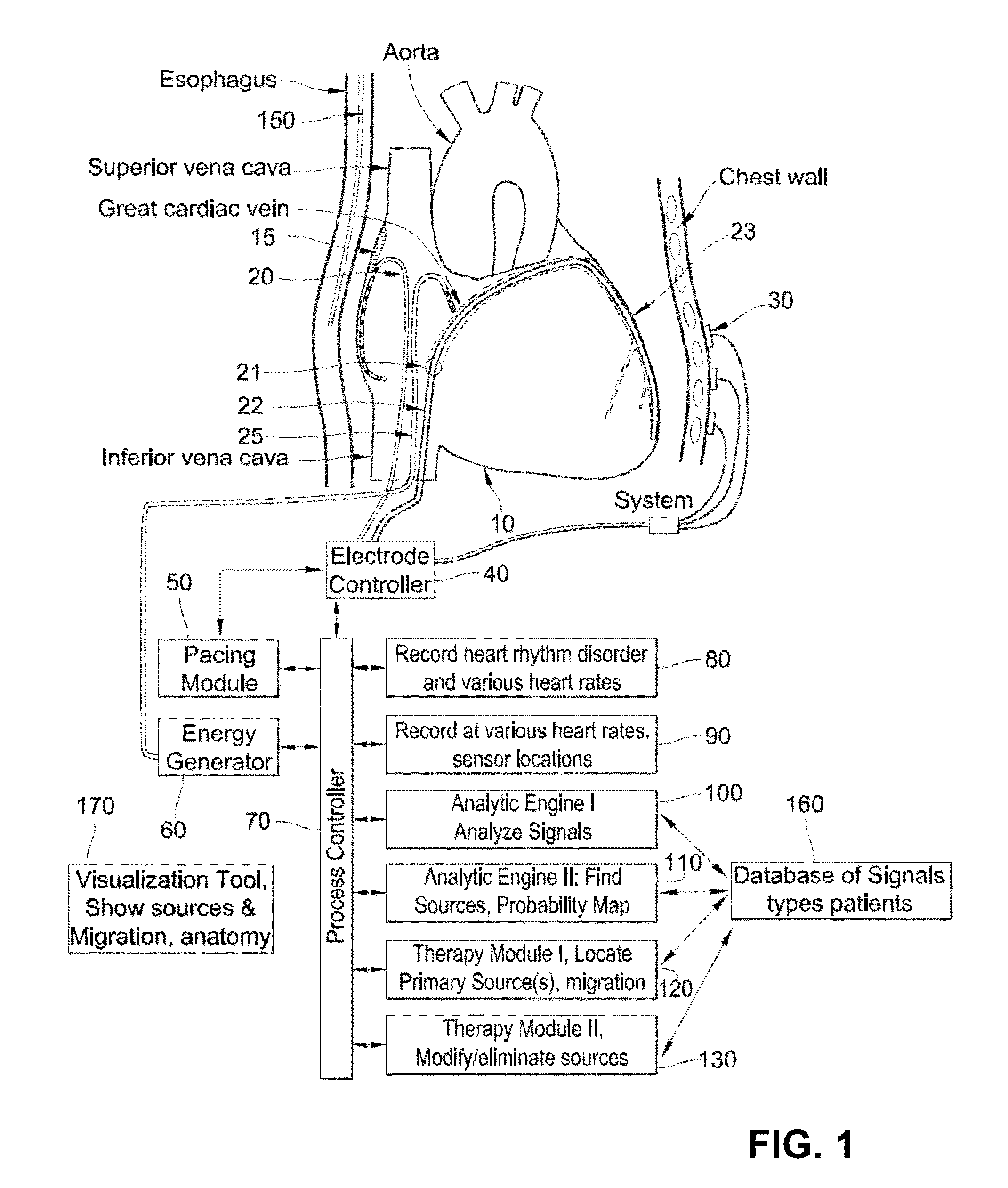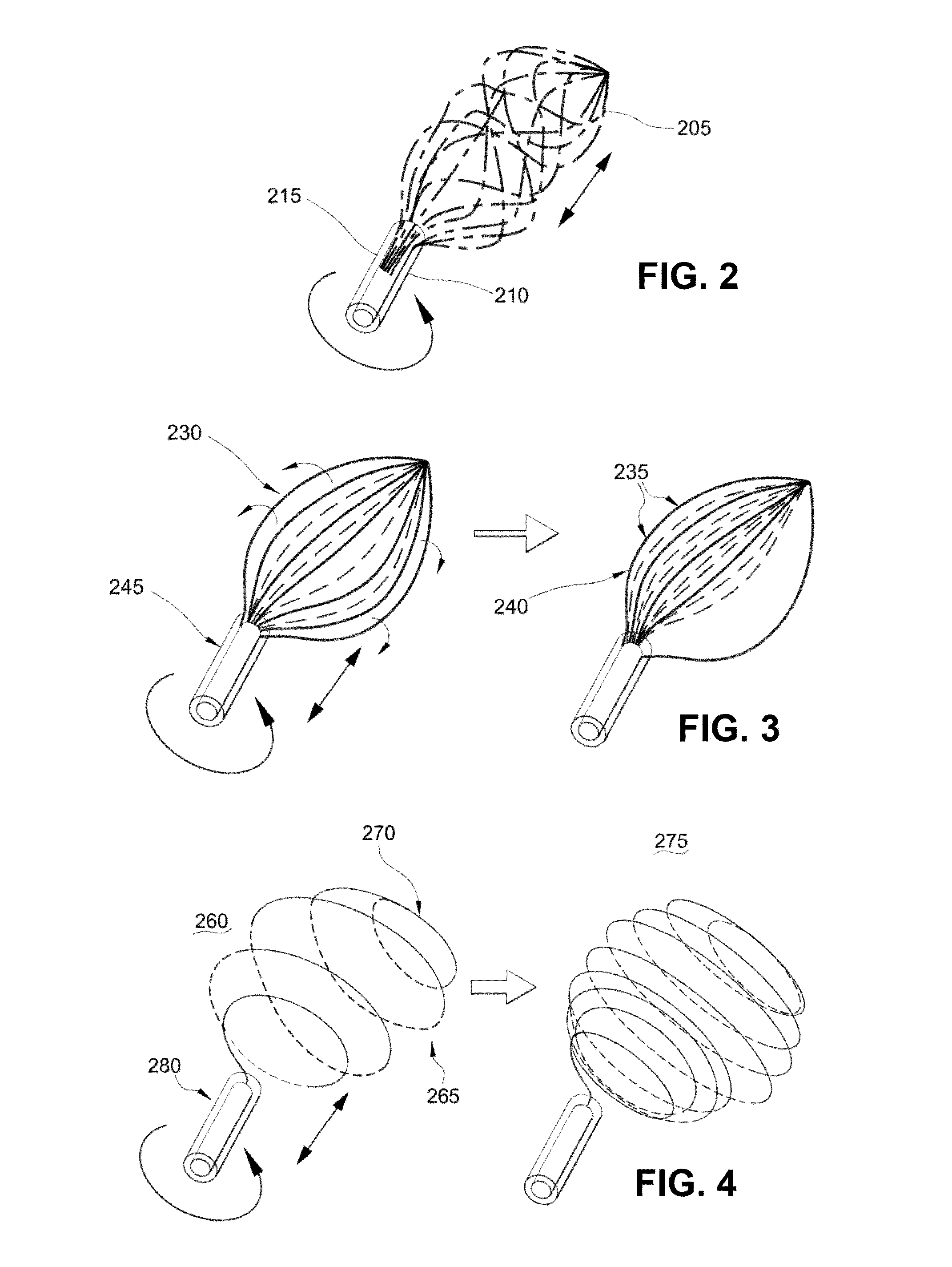Heart rhythm disorders are very common in the United States, and are significant causes of morbidity, lost days from work, and death.
Under certain conditions, rapid activation of the normal sinus node can cause the heart rhythm disorder of inappropriate sinus
tachycardia or sinus node reentry.
Treatment of heart rhythm disorders, particularly the complex rhythm disorders of AF, VF and VT, can be very difficult.
This is in part because tools to identify and locate the cause of the heart rhythm disorder are poor, hindering attempts to deliver energy to the correct region to terminate and eliminate the disorder.
This discrepancy is due to the fact that the sources for AF are extremely difficult to identify.
None of the
catheter systems is designed to conform
ablation therapy to the shape of the actual source of the rhythm disorder within heart tissue, since such source shapes are currently not discussed, studied or defined, particularly for complex heart rhythm disorders.
Difficulties in identifying the precise source of a heart rhythm disorder for ablation depend on the fact that most sophisticated known systems display data that the practitioner has to interpret, without directly identifying and locating the cause of the disorder to enable the practitioner to detect, diagnose and treat it.
These methods and instruments detect, analyze and display electrical potentials, often in sophisticated 3-dimensional anatomic representations, but still fail to identify and locate the cause of heart rhythm disorders, particularly for complex disorders such as AF.
Certain known methods for identifying and locating causes for heart rhythm disorders may work in simple rhythm disorders, but there are no known methods that have been successful with respect to identifying causes for complex disorders such as AF, VF or polymorphic VT.
Moreover, no technique currently identifies the size and shape of
ablation therapy to eliminate the heart rhythm disorder while minimizing damage to non-involved (normal) tissue of the heart.
Entrainment mapping uses pacing to identify sites where the stimulating
electrode is at the cause of a rhythm, yet pacing cannot be applied in AF and even some ‘simple’ rhythms such as atrial tachycardias due to automatic mechanisms.
Thus, no methods yet exist to precisely identify the position, size and shape of sources for complex heart rhythm disorders such as AF (Calkins, Brugada et al.
Moreover, this
system does not identify or locate a cause, since it examines diastolic intervals (between activations) rather than activation itself.
Moreover, the method of using feature and detection localization algorithms will not work for complex rhythms such as AF and VF, where activation within the heart changes from beat to beat.
However, this is not accepted for complex rhythms with varying activation paths such as AF or VF.
This approach will not work for simple arrhythmias due to reentry, in which there is no “earliest” site in reentry because activation is a continuous ‘circle’.
This approach will also not work for complex arrhythmias in which activation varies from beat to beat, such as AF or VF.
However, even in simple heart rhythm disorders, it is often difficult to apply known methods to identify causes.
Thus, ablating the cause of a heart rhythm disorder can be challenging, and even experienced practitioners may require hours to ablate certain ‘simple’ rhythm disorders (with consistent beat-to-beat activation patterns) such as
atrial tachycardia or atypical (
left atrial) AFL.
The situation is more difficult still for complex heart rhythm disorders such as AF and VF where activation sequences vary from beat-to-beat.
These prior art solutions are extremely difficult to apply to complex rhythms such as AF or VF where signals for each beat at any site (‘cycle’) may transition between one, several, and multiple deflections over a short period of time.
Unfortunately, these
animal data have not translated into effective human therapy.
In AF patients, sites where rate is high (or, sites of high spectral
dominant frequency, DF) have not been useful targets for ablation.
In part, this may be because the DF method that is effective in animals may be inaccurate in human AF for many reasons, as shown by many workers (Ng, Kadish et al.
However, this method has also been questioned.
This patent, as a result, does not identify and locate the cause for a heart rhythm disorder.
However, this assumption may not be correct.
This lack of identifying and locating a cause for AF may explain why methods based on organization have not yet translated into improved treatment to acutely terminate AF.
However, this patent does not identify or locate a cause of a heart rhythm disorder.
Thus, while it would be desirable to identify (and then locate) localized causes for human AF, this has not been possible.
Identifying and locating causes for VT may be difficult and ablation is performed at specialized centers.
2007), but again this is very poorly understood in humans.
2009) but cannot yet be performed in a wider
population.
However, such tools typically have a limited
field of view that is inadequate to identify causes for AF, that may lie anywhere in either atria and vary (Waldo and Feld 2008).
Alternatively, they may require so many amplifiers for wide-area sampling that they are impractical for
human use.
2004)), and introduce problems by exposing the heart to air,
anesthesia and other agents that may alter the rhythm disorder from the form that occurs clinically.
 Login to View More
Login to View More  Login to View More
Login to View More 









